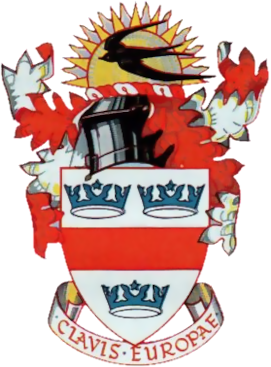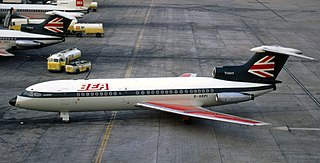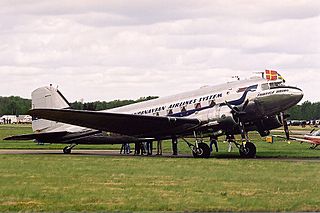
Heathrow Airport, called London Airport until 1966 and now known as London Heathrow, is the main international airport serving London, England. It is the largest of the six international airports in the London airport system. The airport is owned and operated by Heathrow Airport Holdings. In 2022, it was the second-busiest airport in the world by international passenger traffic and the second busiest airport in Europe.

The Airspeed AS.57 Ambassador is a British twin piston-engined airliner that was designed and produced by the British aircraft manufacturer Airspeed Ltd. It was one of the first postwar airliners to be produced.

British European Airways (BEA), formally British European Airways Corporation, was a British airline which existed from 1946 until 1974.

British European Airways Flight 548 was a scheduled passenger flight from London Heathrow to Brussels that crashed near Staines, Surrey, England, soon after take-off on 18 June 1972, killing all 118 people on board. The accident became known as the Staines air disaster. As of 2023, it remains the deadliest air accident in the United Kingdom and was the deadliest air accident involving a Hawker Siddeley Trident. One passenger initially survived the impact but died of his injuries soon after.

The 1977 Dan-Air/IAS Cargo Boeing 707 crash was a fatal accident involving a Boeing 707-321C cargo aircraft operated by Dan Air Services Limited on behalf of International Aviation Services Limited, which had been sub-contracted by Zambia Airways Corporation to operate a weekly scheduled all-cargo service between London Heathrow and the Zambian capital Lusaka via Athens and Nairobi. The aircraft crashed during approach to Lusaka Airport, Zambia, on 14 May 1977. All six crew members of the aircraft were killed.

The Hawker Siddeley HS-121 Trident is a British airliner produced by Hawker Siddeley. In 1957, de Havilland proposed its DH.121 trijet design to a British European Airways (BEA) request. By 1960, de Havilland had been acquired by Hawker Siddeley. The Trident's maiden flight happened on 9 January 1962, and it was introduced on 1 April 1964, two months after its main competitor, the Boeing 727. By the end of the programme in 1978, 117 Tridents had been produced. The Trident was withdrawn from service in 1995.

Channel Airways was a private airline formed in the United Kingdom in 1946 as East Anglian Flying Services.

British Airways Flight 38 was a scheduled international passenger flight from Beijing Capital International Airport in Beijing, China, to London Heathrow Airport in London, United Kingdom, an 8,100-kilometre trip. On 17 January 2008, the Boeing 777-200ER aircraft operating the flight crashed just short of the runway while landing at Heathrow. No fatalities occurred; of the 152 people on board, 47 sustained injuries, one serious. It was the first time in the aircraft type's history that a Boeing 777 was declared a hull loss, and subsequently written off.
Northeast Airlines (NEA) – known as BKS Air Transport until 1970 – was an airline based in the United Kingdom that operated from 1952 until 1976, when NEA's operations and fleet were merged into British Airways.

BOAC Flight 712 was a British Overseas Airways Corporation (BOAC) service operated by a Boeing 707-465 from London Heathrow Airport bound for Sydney via Zurich and Singapore. On Monday 8 April 1968, it suffered an engine failure on takeoff that quickly led to a major fire; the engine detached from the aircraft in flight. After the aircraft had made a successful emergency landing, confusion over checklists and distractions from the presence of a check pilot contributed to the deaths of five of the 127 on board. The direct cause of the fire was the failure of a compressor wheel, due to metal fatigue.

British United Airways Flight 1030X crashed on 14 April 1965 on Jersey in the Channel Islands. Poor visibility and low cloud cover resulted in an aborted landing attempt, leading to a second attempt which ended with the Douglas C-47B hitting the outermost pole of the approach lighting system before crashing into a field and catching fire. The crash killed all 23 passengers and three of the crew on board; a flight attendant was the only survivor of the accident.

British European Airways Flight 411 crashed on approach to Manchester Airport after a flight from Amsterdam Schiphol International Airport on 14 March 1957 and hit a house in Wythenshawe. All on board, 20 passengers and crew, died in the crash as did two people in the house. The aircraft involved was a Vickers Viscount registration G-ALWE operated by British European Airways. The cause of the crash was metal fatigue in flaps causing loss of control.

The 1957 Nutts Corner BEA Viscount crash was a British European Airways (BEA) flight from London to Belfast that crashed at Nutts Corner Airport on 23 October 1957, killing all seven passengers and crew.

The 1950 Heathrow BEA Vickers Viking crash occurred on 31 October 1950 when a Vickers Viking operated by British European Airways (BEA) crashed at London Airport in heavy fog. The aircraft was on a scheduled flight between Paris and London's Northolt airport and 28 of the 30 passengers and crew on board were killed.

The 1947 Croydon Dakota accident occurred on 25 January 1947 when a Spencer Airways Douglas C-47A Skytrain (Dakota) failed to get airborne from Croydon Airport near London, and crashed into a parked and empty ČSA Douglas C-47 destroying both aircraft and killing 11 passengers and one crew member.

Central African Airways Flight 890, a Vickers Viscount 745D, crashed during a scheduled passenger flight from Wadi Halfa, Sudan, to Benghazi, Libya, about nine kilometers southeast of Benina International Airport in Libya. A total of forty-seven passengers and seven crew members were on board of whom only eighteen survived, making it the deadliest ever plane crash in Libya at the time of the accident. It still remains the deadliest accident for Central African Airways.

The 1965 Skyways Coach-Air Avro 748 crash occurred on 11 July 1965 when Avro 748-101 Series 1 G-ARMV, flown during a scheduled international passenger flight from Beauvais Airport, Oise, France, crashed on landing at its intended destination of Lympne Airport, Kent, United Kingdom. The accident was due to the grass runway being unable to support the weight of the aircraft during a heavy landing. This caused the nose wheels to dig in and the aircraft to overturn, losing both wings and the starboard tailplane in the process. All 52 people on board survived. This was the first accident involving the Avro 748/HS 748 that resulted in a write-off. A concrete runway was later installed at Lympne.

British Overseas Airways Corporation (BOAC) was the British state-owned airline created in 1939 by the merger of Imperial Airways and British Airways Ltd. It continued operating overseas services throughout World War II. After the passing of the Civil Aviation Act 1946, European and South American services passed to two further state-owned airlines, British European Airways (BEA) and British South American Airways (BSAA). BOAC absorbed BSAA in 1949, but BEA continued to operate British domestic and European routes for the next quarter century. The Civil Aviation Act 1971 merged BOAC and BEA, effective 31 March 1974, forming today's British Airways.


















